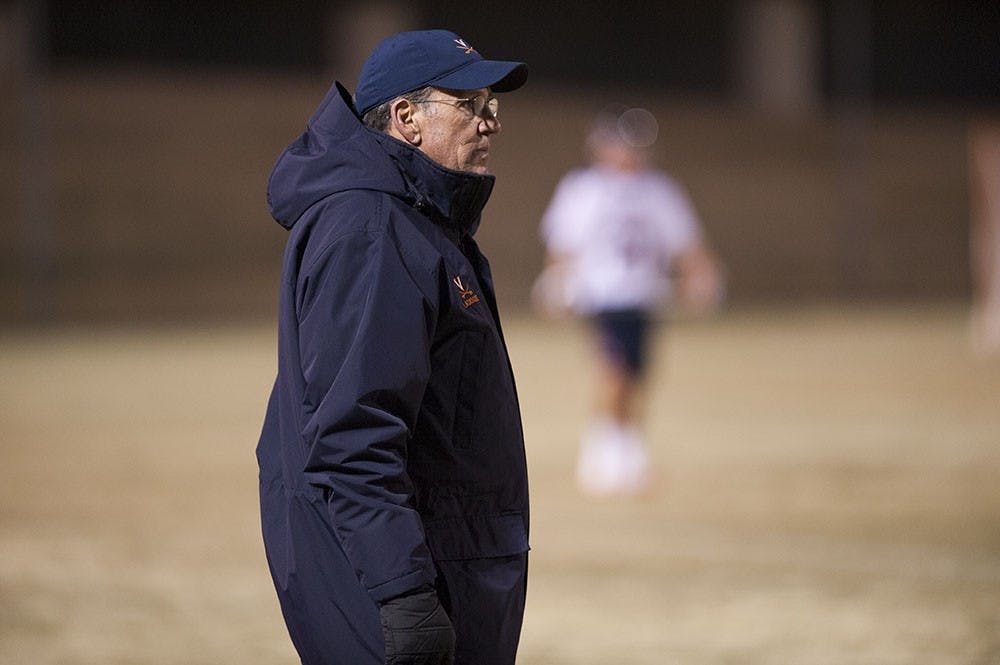Sunday, the Virginia men’s lacrosse team will begin postseason play against Johns Hopkins for the second consecutive year. For the Cavaliers, the first-round showdown might just be the program’s biggest contest since the 2011 national championship game.
Of course, the fact that it is an NCAA tournament contest raises the stakes. Sunday will be the final game played in Klöckner Stadium for Virginia’s seniors.
Furthermore, the game is against lacrosse blue blood and longtime rival Johns Hopkins (9-6, 4-1 Big Ten). The Blue Jays, who rebounded from a 4-6 start to win their final five games en route to the Big Ten Championship, battle the Cavaliers (10-4, 0-4 ACC) annually for the Doyle Smith Cup. The Blue Jays ended Virginia’s title hopes last May in a dominating 14-8 route.
But more importantly, Sunday provides the Cavaliers the opportunity to ascend from mediocrity and again establish themselves among college lacrosse’s elite.
By all means, coach Dom Starsia’s bunch exceeded expectations for what was supposed to be a rebuilding year. The Cavaliers lost every defensive starter from the 2014 season except for sophomore goalie Matt Barrett. Then in March 2015, Virginia lost its leading scorer from 2014 and arguably its best shooter in All-American junior attackman James Pannell after he tore his ACL during practice.
Still, outstanding senior leadership from the likes of attackman Owen Van Arsdale and defenseman Davi Sacco kept Virginia focused, propelling the team to a perfect 10-0 record in its out-of-conference slate.
But on the flip side, the Cavaliers have struggled mightily in ACC play, dropping all four games and missing the conference tournament for the second consecutive season.
Now, the ACC is undoubtedly the best conference in men’s collegiate lacrosse. In fact, arguments could be made that it is the best conference in any Division I sport. The RPI rankings, which account for strength of schedule, lists Syracuse, Notre Dame, North Carolina and Duke as the top four teams in the country, respectively. Virginia is sixth.
So the issue is not so much that the Cavaliers could not squeak out a win against any of their ACC foes. Rather, it is the way in which they lost.
In a March 1 contest against Syracuse at the Carrier Dome, the Orange took off with a 7-0 lead, essentially ending the game before halftime. A similar story was written two weeks later against the Irish, who stymied Virginia by entering halftime with an 8-2 advantage.
When North Carolina came to Charlottesville, the Cavalier defense held the Tar Heels, who boast the nation’s second best scoring offense at 14.53 goals per game, to just 10 goals. But 18 turnovers prevented Virginia from netting more than six of its own. And as usual, Duke, which has been the Cavaliers’ kryptonite for the better part of a decade, dismissed Virginia, 15-8.
In short, Virginia’s inconsistencies — offensively, defensively and at the faceoff X — have been greatly exposed in its four biggest games this season.
Some mistakes can easily be assigned to the inexperience of a young roster. Barrett, whose 2015 excellence earned him a spot on the All-ACC team, was thrust into the defense’s elder statesman role as Virginia experimented with lineups at the start of the season. And the Cavaliers’ two faceoff specialists, Jeff Kratky and Jason Murphy, are just a sophomore and redshirt freshman, respectively.
But no such excuse existed on the offensive end, which despite the loss of Pannell and the graduation of Mark Cockerton, is laden with talent.
Through the past two games, that talent seems to have found its groove. Virginia dominated possession in a 12-9 win against Georgetown and a 12-6 victory against Pennsylvania.
Sophomore attackman Ryan Lukacovic, who is Virginia’s triggerman behind the cage, tallied seven goals and four assists in that stretch, even drawing comparisons to former Cavalier great Steele Stanwick, the 2011 Tewaaraton winner.
Ironically enough, two of Steele’s younger brothers, attackmen Wells and Shack Stanwick, lead a potent Blue Jay offense which put up 15 goals in an overtime loss against Virginia March 21.
Despite the great defensive improvement witnessed throughout the season by the Klöckner faithful, Sunday’s contest is likely to be high scoring; games between Virginia and Johns Hopkins always are.
The real question is whether the Cavalier offense can keep pace. And really, that will be the key to Virginia’s postseason run, however many games it lasts.
Barrett will likely continue his strong play in goal. Meanwhile, Kratky and Murphy, although neither is a superstar, have developed into respectable faceoff men.
But can Lukacovic continue his torrid pace? Can senior midfielder Ryan Tucker avoid another 0-19 shooting slump? Can sophomore midfielder Zed Williams avoid turnovers and become a more consistent scoring threat?
If the answer to those questions is “yes,” Virginia could be poised for an improbable championship run, similar to that of 2011. After all, from a season-ending demolition of Penn to the fact that both teams earned seven-seeds for the tournament, plenty of similarities exist between 2011 and 2015.
But if even one of those answers is “no,” Virginia, which has won just a single NCAA tournament game since the 2011 championship, will find itself booted from the first round of the tourney for the second consecutive year. And more importantly, for at least another season, Virginia will lose its chance to ascend from mediocrity.







